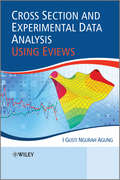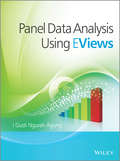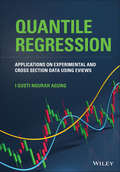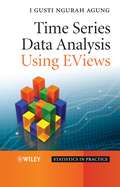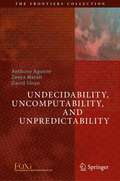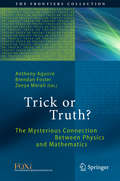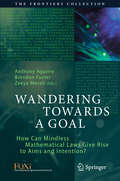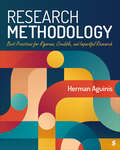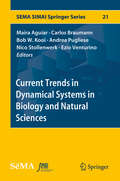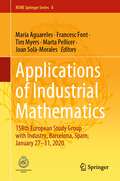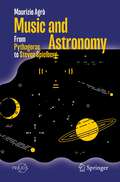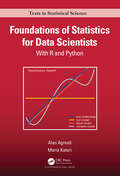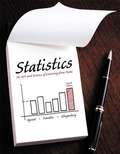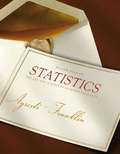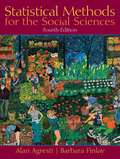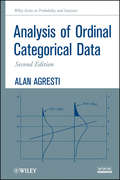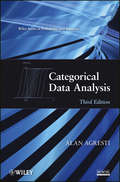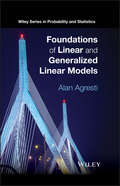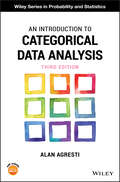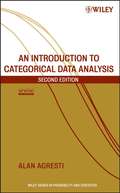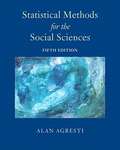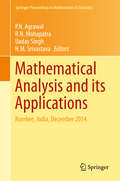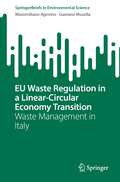- Table View
- List View
Cross Section and Experimental Data Analysis Using EViews
by I. Gusti AgungA practical guide to selecting and applying the most appropriate model for analysis of cross section data using EViews. "This book is a reflection of the vast experience and knowledge of the author. It is a useful reference for students and practitioners dealing with cross sectional data analysis ... The strength of the book lies in its wealth of material and well structured guidelines ..." Prof. Yohanes Eko Riyanto, Nanyang Technological University, Singapore "This is superb and brilliant. Prof. Agung has skilfully transformed his best experiences into new knowledge ... creating a new way of understanding data analysis." Dr. I Putu Gede Ary Suta, The Ary Suta Center, Jakarta Basic theoretical concepts of statistics as well as sampling methods are often misinterpreted by students and less experienced researchers. This book addresses this issue by providing a hands-on practical guide to conducting data analysis using EViews combined with a variety of illustrative models (and their extensions). Models having numerically dependent variables based on a cross-section data set (such as univariate, multivariate and nonlinear models as well as non-parametric regressions) are concentrated on. It is shown that a wide variety of hypotheses can easily be tested using EViews. Cross Section and Experimental Data Analysis Using EViews: Provides step-by-step directions on how to apply EViews to cross section data analysis - from multivariate analysis and nonlinear models to non-parametric regression Presents a method to test for all possible hypotheses based on each model Proposes a new method for data analysis based on a multifactorial design model Demonstrates that statistical summaries in the form of tabulations are invaluable inputs for strategic decision making Contains 200 examples with special notes and comments based on the author’s own empirical findings as well as over 400 illustrative outputs of regressions from EViews Techniques are illustrated through practical examples from real situations Comes with supplementary material, including work-files containing selected equation and system specifications that have been applied in the book This user-friendly introduction to EViews is ideal for Advanced undergraduate and graduate students taking finance, econometrics, population, or public policy courses, as well as applied policy researchers.
Panel Data Analysis using EViews
by I Gusti AgungA comprehensive and accessible guide to panel data analysis using EViews softwareThis book explores the use of EViews software in creating panel data analysis using appropriate empirical models and real datasets. Guidance is given on developing alternative descriptive statistical summaries for evaluation and providing policy analysis based on pool panel data. Various alternative models based on panel data are explored, including univariate general linear models, fixed effect models and causal models, and guidance on the advantages and disadvantages of each one is given.Panel Data Analysis using EViews:Provides step-by-step guidance on how to apply EViews software to panel data analysis using appropriate empirical models and real datasets. Examines a variety of panel data models along with the author's own empirical findings, demonstrating the advantages and limitations of each model.Presents growth models, time-related effects models, and polynomial models, in addition to the models which are commonly applied for panel data.Includes more than 250 examples divided into three groups of models (stacked, unstacked, and structured panel data), together with notes and comments.Provides guidance on which models not to use in a given scenario, along with advice on viable alternatives.Explores recent new developments in panel data analysisAn essential tool for advanced undergraduate or graduate students and applied researchers in finance, econometrics and population studies. Statisticians and data analysts involved with data collected over long time periods will also find this book a useful resource.
Quantile Regression: Applications on Experimental and Cross Section Data using EViews
by I. Gusti AgungQUANTILE REGRESSION A thorough presentation of Quantile Regression designed to help readers obtain richer information from data analysesThe conditional least-square or mean-regression (MR) analysis is the quantitative research method used to model and analyze the relationships between a dependent variable and one or more independent variables, where each equation estimation of a regression can give only a single regression function or fitted values variable. As an advanced mean regression analysis, each estimation equation of the mean-regression can be used directly to estimate the conditional quantile regression (QR), which can quickly present the statistical results of a set nine QR(τ)s for τ(tau)s from 0.1 up to 0.9 to predict detail distribution of the response or criterion variable. QR is an important analytical tool in many disciplines such as statistics, econometrics, ecology, healthcare, and engineering.Quantile Regression: Applications on Experimental and Cross Section Data Using EViews provides examples of statistical results of various QR analyses based on experimental and cross section data of a variety of regression models. The author covers the applications of one-way, two-way, and n-way ANOVA quantile regressions, QRs with multi numerical predictors, heterogeneous QRs, and latent variables QRs, amongst others. Throughout the text, readers learn how to develop the best possible quantile regressions and how to conduct more advanced analysis using methods such as the quantile process, the Wald test, the redundant variables test, residual analysis, the stability test, and the omitted variables test. This rigorous volume:Describes how QR can provide a more detailed picture of the relationships between independent variables and the quantiles of the criterion variable, by using the least-square regressionPresents the applications of the test for any quantile of any numerical response or criterion variableExplores relationship of QR with heterogeneity: how an independent variable affects a dependent variableOffers expert guidance on forecasting and how to draw the best conclusions from the results obtainedProvides a step-by-step estimation method and guide to enable readers to conduct QR analysis using their own data setsIncludes a detailed comparison of conditional QR and conditional mean regressionQuantile Regression: Applications on Experimental and Cross Section Data Using EViews is a highly useful resource for students and lecturers in statistics, data analysis, econometrics, engineering, ecology, and healthcare, particularly those specializing in regression and quantitative data analysis.
Time Series Data Analysis Using EViews: Forecasting Using Eviews
by I. Gusti AgungDo you want to recognize the most suitable models for analysis of statistical data sets? This book provides a hands-on practical guide to using the most suitable models for analysis of statistical data sets using EViews - an interactive Windows-based computer software program for sophisticated data analysis, regression, and forecasting - to define and test statistical hypotheses. Rich in examples and with an emphasis on how to develop acceptable statistical models, Time Series Data Analysis Using EViews is a perfect complement to theoretical books presenting statistical or econometric models for time series data. The procedures introduced are easily extendible to cross-section data sets. The author: Provides step-by-step directions on how to apply EViews software to time series data analysis Offers guidance on how to develop and evaluate alternative empirical models, permitting the most appropriate to be selected without the need for computational formulae Examines a variety of times series models, including continuous growth, discontinuous growth, seemingly causal, regression, ARCH, and GARCH as well as a general form of nonlinear time series and nonparametric models Gives over 250 illustrative examples and notes based on the author's own empirical findings, allowing the advantages and limitations of each model to be understood Describes the theory behind the models in comprehensive appendices Provides supplementary information and data sets An essential tool for advanced undergraduate and graduate students taking finance or econometrics courses. Statistics, life sciences, and social science students, as well as applied researchers, will also find this book an invaluable resource.
Undecidability, Uncomputability, and Unpredictability (The Frontiers Collection)
by Anthony Aguirre Zeeya Merali David SloanFor a brief time in history, it was possible to imagine that a sufficiently advanced intellect could, given sufficient time and resources, in principle understand how to mathematically prove everything that was true. They could discern what math corresponds to physical laws, and use those laws to predict anything that happens before it happens. That time has passed. Gödel’s undecidability results (the incompleteness theorems), Turing’s proof of non-computable values, the formulation of quantum theory, chaos, and other developments over the past century have shown that there are rigorous arguments limiting what we can prove, compute, and predict. While some connections between these results have come to light, many remain obscure, and the implications are unclear. Are there, for example, real consequences for physics — including quantum mechanics — of undecidability and non-computability? Are there implications for our understanding of the relations between agency, intelligence, mind, and the physical world? This book, based on the winning essays from the annual FQXi competition, contains ten explorations of Undecidability, Uncomputability, and Unpredictability. The contributions abound with connections, implications, and speculations while undertaking rigorous but bold and open-minded investigation of the meaning of these constraints for the physical world, and for us as humans.
Trick or Truth?
by Anthony Aguirre Brendan Foster Zeeya MeraliThe prize-winning essays in thisbook address the fascinating but sometimes uncomfortable relationship betweenphysics and mathematics. Ismathematics merely another natural science? Or is it the result of humancreativity? Does physics simply wear mathematics like a costume, or is math thelifeblood of physical reality? The nineteen wide-ranging, highly imaginative and oftenentertaining essays are enhanced versions of the prize-winning entries to theFQXi essay competition "Trick or Truth", which attracted over 200 submissions. The Foundational QuestionsInstitute, FQXi, catalyzes, supports, and disseminates research on questions atthe foundations of physics and cosmology, particularly new frontiers andinnovative ideas integral to a deep understanding of reality, but unlikely tobe supported by conventional funding sources.
Wandering Towards a Goal: How Can Mindless Mathematical Laws Give Rise To Aims And Intention? (The Frontiers Collection)
by Anthony Aguirre Brendan Foster Zeeya MeraliThis collection of prize-winning essays addresses the controversial question of how meaning and goals can emerge in a physical world governed by mathematical laws. What are the prerequisites for a system to have goals? What makes a physical process into a signal? Does eliminating the homunculus solve the problem? The three first-prize winners, Larissa Albantakis, Carlo Rovelli and Jochen Szangolies tackle exactly these challenges, while many other aspects (agency, the role of the observer, causality versus teleology, ghosts in the machine etc.) feature in the other award winning contributions. All contributions are accessible to non-specialists.These seventeen stimulating and often entertaining essays are enhanced versions of the prize-winning entries to the FQXi essay competition in 2017.The Foundational Questions Institute, FQXi, catalyzes, supports, and disseminates research on questions at the foundations of physics and cosmology, particularly new frontiers and innovative ideas integral to a deep understanding of reality, but unlikely to be supported by conventional funding sources.
Research Methodology: Best Practices for Rigorous, Credible, and Impactful Research
by Herman AguinisResearch Methodology: Best Practices for Rigorous, Credible, and Impactful Research takes a 360-degree view of understanding and doing research, helping readers become expert researchers, reviewers, and consumers of research. Renowned author, journal editor, and researcher Herman Aguinis distills the vast body of work on methodological best practices into a singular experience. Each of the 16 chapters thoroughly explains a different aspect of methodology step by step, from choosing useful and compelling research topics to reporting results accurately and credibly. Researchers at all career stages will find this text helpful to structure and conduct high-impact empirical research aimed at producing a thesis, dissertation, or journal publication. Research consumers will find instruction on how to evaluate the rigor and credibility of research conducted by others. Instructors will find the book’s modular approach refreshing by assigning students the most relevant topics—from checklists of best practices to an in-depth treatment of a methodology. Filled with "how-to’s" and "dos and don’ts", figures, hands-on exercises, and "Methods in Practice" boxes that summarize and apply best practices, this book is a must-have for anyone interested in producing or reading research. Included with this title: LMS Cartridge: Import this title’s instructor resources into your school’s learning management system (LMS) and save time. Don’t use an LMS? You can still access all of the same online resources for this title via the password-protected Instructor Resource Site. Learn more.
Research Methodology: Best Practices for Rigorous, Credible, and Impactful Research
by Herman AguinisResearch Methodology: Best Practices for Rigorous, Credible, and Impactful Research takes a 360-degree view of understanding and doing research, helping readers become expert researchers, reviewers, and consumers of research. Renowned author, journal editor, and researcher Herman Aguinis distills the vast body of work on methodological best practices into a singular experience. Each of the 16 chapters thoroughly explains a different aspect of methodology step by step, from choosing useful and compelling research topics to reporting results accurately and credibly. Researchers at all career stages will find this text helpful to structure and conduct high-impact empirical research aimed at producing a thesis, dissertation, or journal publication. Research consumers will find instruction on how to evaluate the rigor and credibility of research conducted by others. Instructors will find the book’s modular approach refreshing by assigning students the most relevant topics—from checklists of best practices to an in-depth treatment of a methodology. Filled with "how-to’s" and "dos and don’ts", figures, hands-on exercises, and "Methods in Practice" boxes that summarize and apply best practices, this book is a must-have for anyone interested in producing or reading research. Included with this title: LMS Cartridge: Import this title’s instructor resources into your school’s learning management system (LMS) and save time. Don’t use an LMS? You can still access all of the same online resources for this title via the password-protected Instructor Resource Site. Learn more.
Current Trends in Dynamical Systems in Biology and Natural Sciences (SEMA SIMAI Springer Series #21)
by Maira Aguiar Carlos Braumann Bob W. Kooi Andrea Pugliese Nico Stollenwerk Ezio VenturinoThis book disseminates the latest results and envisages new challenges in the application of mathematics to various practical situations in biology, epidemiology, and ecology. It comprises a collection of the main results presented at the Ninth Edition of the International Workshop “Dynamical Systems Applied to Biology and Natural Sciences – DSABNS”, held from 7 to 9 February 2018 at the Department of Mathematics, University of Turin, Italy. While the principal focus is ecology and epidemiology, the coverage extends even to waste recycling and a genetic application. The topics covered in the 12 peer-reviewed contributions involve such diverse mathematical tools as ordinary and partial differential equations, delay equations, stochastic equations, control, and sensitivity analysis. The book is intended to help both in disseminating the latest results and in envisaging new challenges in the application of mathematics to various practical situations in biology, epidemiology, and ecology.
Applications of Industrial Mathematics: 158th European Study Group with Industry, Barcelona, Spain, January 27–31, 2020 (RSME Springer Series #8)
by Maria Aguareles Francesc Font Tim Myers Marta Pellicer Joan Solà-MoralesThis book collects the results presented at the 158th European Study Group with Industry, which took place at the Centre de Recerca Matemàtica in Barcelona in January 2020. The European Study Groups with Industry are a well-recognised forum where mathematicians work with industrial representatives on issues of current interest to companies. At this particular meeting, the problems were chosen to provide a wide variety of subject areas and to appeal to local academics. In this work, the research carried out and the solutions presented to the companies are detailed. In particular, the book focuses on: estimating the difficulty level of mobile games; modelling the stability of human towers; fibre coating in the manufacture of clutch components; safe trajectories of robot arms. The book provides an excellent addition to the canon of Industrial Mathematics. It is addressed to researchers keen to apply mathematics to topical, real-world problems.
Music and Astronomy: From Pythagoras to Steven Spielberg (Springer Praxis Books)
by Maurizio AgròThis book explores the profound and ancient relationship between music and astronomy. Throughout history, Music has occupied a significant place among the disciplines of the Quadrivium, which also include Geometry, Arithmetic, and Astronomy. The captivating bond between these two realms has not only inspired eminent scientists like Kepler, Newton, and Einstein, but has also captured the imagination of NASA and astronauts in modern times. The author delves into various aspects of the intersection between music and astronomy, encompassing everything from ancient cosmological beliefs to groundbreaking discoveries such as the cosmic background radiation and gravitational waves. This enthralling theme has not only stimulated renowned artists like David Bowie and Elton John, but has also served as a muse for movies like Close Encounters of the Third Kind. Within the book, readers will find an extensive photo gallery and a specially curated soundtrack that enhances the reading experience. It caters to a broad audience, appealing to those with a general interest in both music and astronomy, as well as to specialized individuals in either field of study.
Foundations of Statistics for Data Scientists: With R and Python (Chapman & Hall/CRC Texts in Statistical Science)
by Alan Agresti Maria KateriFoundations of Statistics for Data Scientists: With R and Python is designed as a textbook for a one- or two-term introduction to mathematical statistics for students training to become data scientists. It is an in-depth presentation of the topics in statistical science with which any data scientist should be familiar, including probability distributions, descriptive and inferential statistical methods, and linear modeling. The book assumes knowledge of basic calculus, so the presentation can focus on "why it works" as well as "how to do it." Compared to traditional "mathematical statistics" textbooks, however, the book has less emphasis on probability theory and more emphasis on using software to implement statistical methods and to conduct simulations to illustrate key concepts. All statistical analyses in the book use R software, with an appendix showing the same analyses with Python. The book also introduces modern topics that do not normally appear in mathematical statistics texts but are highly relevant for data scientists, such as Bayesian inference, generalized linear models for non-normal responses (e.g., logistic regression and Poisson loglinear models), and regularized model fitting. The nearly 500 exercises are grouped into "Data Analysis and Applications" and "Methods and Concepts." Appendices introduce R and Python and contain solutions for odd-numbered exercises. The book's website has expanded R, Python, and Matlab appendices and all data sets from the examples and exercises.
Statistics: The Art and Science of Learning from Data (Fourth Edition)
by Alan Agresti Christine Franklin Bernhard KlingenbergThe fourth edition of this textbook aims at improving the student and instructor user experience to learn statistics from the traditional formula-driven mathematical statistics course to a concept-driven approach. This concept-driven approach places more emphasis on why statistics is important in the real world and places less emphasis on mathematical probability. The book aims to help students make the conceptual approach more interesting and more readily accessible.
Statistics: The Art and Science of Learning from Data (2nd Edition)
by Alan Agresti Christine FranklinAlan Agresti and Chris Franklin have merged their research and classroom experience to develop this successful introductory statistics text. Statistics: The Art and Science of Learning from Data, Second Edition helps readers become statistically literate by encouraging them to ask and answer interesting statistical questions. It takes the ideas that have turned statistics into a central science in modern life and makes them accessible and engaging to readers without compromising necessary rigor.
Statistical Methods for the Social Sciences
by Alan Agresti Barbara FinlayThe book presents an introduction to statistical methods for students majoring in social science disciplines. No previous knowledge of statistics is assumed, and mathematical background is assumed to be minimal (lowest-level high-school algebra).
Analysis of Ordinal Categorical Data (Wiley Series in Probability and Statistics #656)
by Alan AgrestiStatistical science’s first coordinated manual of methods for analyzing ordered categorical data, now fully revised and updated, continues to present applications and case studies in fields as diverse as sociology, public health, ecology, marketing, and pharmacy. Analysis of Ordinal Categorical Data, Second Edition provides an introduction to basic descriptive and inferential methods for categorical data, giving thorough coverage of new developments and recent methods. Special emphasis is placed on interpretation and application of methods including an integrated comparison of the available strategies for analyzing ordinal data. Practitioners of statistics in government, industry (particularly pharmaceutical), and academia will want this new edition.
Categorical Data Analysis
by Alan AgrestiPraise for the Second Edition"A must-have book for anyone expecting to do research and/or applications in categorical data analysis."--Statistics in Medicine"It is a total delight reading this book."--Pharmaceutical Research"If you do any analysis of categorical data, this is an essential desktop reference."--TechnometricsThe use of statistical methods for analyzing categorical data has increased dramatically, particularly in the biomedical, social sciences, and financial industries. Responding to new developments, this book offers a comprehensive treatment of the most important methods for categorical data analysis.Categorical Data Analysis, Third Edition summarizes the latest methods for univariate and correlated multivariate categorical responses. Readers will find a unified generalized linear models approach that connects logistic regression and Poisson and negative binomial loglinear models for discrete data with normal regression for continuous data. This edition also features:An emphasis on logistic and probit regression methods for binary, ordinal, and nominal responses for independent observations and for clustered data with marginal models and random effects modelsTwo new chapters on alternative methods for binary response data, including smoothing and regularization methods, classification methods such as linear discriminant analysis and classification trees, and cluster analysisNew sections introducing the Bayesian approach for methods in that chapterMore than 100 analyses of data sets and over 600 exercisesNotes at the end of each chapter that provide references to recent research and topics not covered in the text, linked to a bibliography of more than 1,200 sourcesA supplementary website showing how to use R and SAS; for all examples in the text, with information also about SPSS and Stata and with exercise solutionsCategorical Data Analysis, Third Edition is an invaluable tool for statisticians and methodologists, such as biostatisticians and researchers in the social and behavioral sciences, medicine and public health, marketing, education, finance, biological and agricultural sciences, and industrial quality control.
Foundations of Linear and Generalized Linear Models
by Alan AgrestiA valuable overview of the most important ideas and results in statistical analysis Written by a highly-experienced author, Foundations of Linear and Generalized Linear Models is a clear and comprehensive guide to the key concepts and results of linear statistical models. The book presents a broad, in-depth overview of the most commonly used statistical models by discussing the theory underlying the models, R software applications, and examples with crafted models to elucidate key ideas and promote practical model building.The book begins by illustrating the fundamentals of linear models, such as how the model-fitting projects the data onto a model vector subspace and how orthogonal decompositions of the data yield information about effects of explanatory variables. Subsequently, the book covers the most popular generalized linear models, which include binomial and multinomial logistic regression for categorical data, and Poisson and negative binomial loglinear models for count data. Focusing on the theoretical underpinnings of these models, Foundations of Linear and Generalized Linear Models also features:An introduction to quasi-likelihood methods that require weaker distributional assumptions, such as generalized estimating equation methodsAn overview of linear mixed models and generalized linear mixed models with random effects for clustered correlated data, Bayesian modeling, and extensions to handle problematic cases such as high-dimensional problemsNumerous examples that use R software for all text data analysesMore than 400 exercises for readers to practice and extend the theory, methods, and data analysisA supplementary website with datasets for the examples and exercises An invaluable textbook for upper-undergraduate and graduate-level students in statistics and biostatistics courses, Foundations of Linear and Generalized Linear Models is also an excellent reference for practicing statisticians and biostatisticians, as well as anyone who is interested in learning about the most important statistical models for analyzing data.
An Introduction to Categorical Data Analysis (Wiley Series in Probability and Statistics #Vol. 308)
by Alan AgrestiA valuable new edition of a standard reference The use of statistical methods for categorical data has increased dramatically, particularly for applications in the biomedical and social sciences. An Introduction to Categorical Data Analysis, Third Edition summarizes these methods and shows readers how to use them using software. Readers will find a unified generalized linear models approach that connects logistic regression and loglinear models for discrete data with normal regression for continuous data. Adding to the value in the new edition is: • Illustrations of the use of R software to perform all the analyses in the book • A new chapter on alternative methods for categorical data, including smoothing and regularization methods (such as the lasso), classification methods such as linear discriminant analysis and classification trees, and cluster analysis • New sections in many chapters introducing the Bayesian approach for the methods of that chapter • More than 70 analyses of data sets to illustrate application of the methods, and about 200 exercises, many containing other data sets • An appendix showing how to use SAS, Stata, and SPSS, and an appendix with short solutions to most odd-numbered exercises Written in an applied, nontechnical style, this book illustrates the methods using a wide variety of real data, including medical clinical trials, environmental questions, drug use by teenagers, horseshoe crab mating, basketball shooting, correlates of happiness, and much more. An Introduction to Categorical Data Analysis, Third Edition is an invaluable tool for statisticians and biostatisticians as well as methodologists in the social and behavioral sciences, medicine and public health, marketing, education, and the biological and agricultural sciences.
An Introduction to Categorical Data Analysis
by Alan AgrestiThe use of statistical methods for categorical data is ever increasing in today's world. An Introduction to Categorical Data Analysis, Second Edition provides an applied introduction to the most important methods for analyzing categorical data. This new edition summarizes methods that have long played a prominent role in data analysis, such as chi-squared tests, and also places special emphasis on logistic regression and other modeling techniques for univariate and correlated multivariate categorical responses. This Second Edition features: Two new chapters on the methods for clustered data, with an emphasis on generalized estimating equations (GEE) and random effects models A unified perspective based on generalized linear models An emphasis on logistic regression modeling An appendix that demonstrates the use of SAS(r) for all methods An entertaining historical perspective on the development of the methods Specialized methods for ordinal data, small samples, multicategory data, and matched pairs More than 100 analyses of real data sets and nearly 300 exercises Written in an applied, nontechnical style, the book illustrates methods using a wide variety of real data, including medical clinical trials, drug use by teenagers, basketball shooting, horseshoe crab mating, environmental opinions, correlates of happiness, and much more. An Introduction to Categorical Data Analysis, Second Edition is an invaluable tool for social, behavioral, and biomedical scientists, as well as researchers in public health, marketing, education, biological and agricultural sciences, and industrial quality control.
Statistical Methods for the Social Sciences
by Alan AgrestiStatistical methods applied to social sciences, made accessible to all through an emphasis on concepts Statistical Methods for the Social Sciences introduces statistical methods to students majoring in social science disciplines. With an emphasis on concepts and applications, this book assumes you have no previous knowledge of statistics and only a minimal mathematical background. It contains sufficient material for a two-semester course. The 5th Edition gives you examples and exercises with a variety of “real data.” It includes more illustrations of statistical software for computations and takes advantage of the outstanding applets to explain key concepts, such as sampling distributions and conducting basic data analyses. It continues to downplay mathematics–often a stumbling block for students–while avoiding reliance on an overly simplistic recipe-based approach to statistics.
Mathematical Analysis and its Applications
by P. N. Agrawal R. N. Mohapatra Uaday Singh H. M. SrivastavaThis book discusses recent developments in and the latest research on mathematics, statistics and their applications. All contributing authors are eminent academics, scientists, researchers and scholars in their respective fields, hailing from around the world. The book presents roughly 60 unpublished, high-quality and peer-reviewed research papers that cover a broad range of areas including approximation theory, harmonic analysis, operator theory, fixed-point theory, functional differential equations, dynamical and control systems, complex analysis, special functions, function spaces, summability theory, Fourier and wavelet analysis, and numerical analysis - all of which are topics of great interest to the research community - while further papers highlight important applications of mathematical analysis in science, engineering and related areas. This conference aims at bringing together experts and young researchers in mathematics from all over the world to discuss the latest advances in mathematical analysis and at promoting the exchange of ideas in various applications of mathematics in engineering, physics and biology. This conference encourages international collaboration and provides young researchers an opportunity to learn about the current state of the research in their respective fields.
A Comprehensive Introduction to Sub-Riemannian Geometry (Cambridge Studies in Advanced Mathematics #181)
by Andrei Agrachev Davide Barilari Ugo BoscainSub-Riemannian geometry is the geometry of a world with nonholonomic constraints. In such a world, one can move, send and receive information only in certain admissible directions but eventually can reach every position from any other. In the last two decades sub-Riemannian geometry has emerged as an independent research domain impacting on several areas of pure and applied mathematics, with applications to many areas such as quantum control, Hamiltonian dynamics, robotics and Lie theory. This comprehensive introduction proceeds from classical topics to cutting-edge theory and applications, assuming only standard knowledge of calculus, linear algebra and differential equations. The book may serve as a basis for an introductory course in Riemannian geometry or an advanced course in sub-Riemannian geometry, covering elements of Hamiltonian dynamics, integrable systems and Lie theory. It will also be a valuable reference source for researchers in various disciplines.
EU Waste Regulation in a Linear-Circular Economy Transition: Waste Management in Italy (SpringerBriefs in Environmental Science)
by Massimiliano Agovino Gaetano MusellaWaste management is a topical issue worldwide. In recent years, several requests have been made by citizens and associations to political decision-makers regarding the need for a significant improvement in waste management methods. Particularly considering the significant increase in awareness of social and environmental impacts and the economic consequences of non-virtuous waste management. There is growing attention on legislation and regulation's role in the waste sector. Regulation can help companies and citizens achieve a faster, more effective, and more efficient transition from a linear economy, based on the take-make-dispose paradigm, to a circular economy, in which the potential of waste as resources and secondary raw materials is exploited. This book is set in the wake of economic literature that tackles the transition from the linear to the circular economy. It focuses on the downstream stages of the waste management process (i.e. the waste treatment phase). In this regard, it is proposed a journey through the history of European waste legislation to study the waste sector's transition dynamics from a selfish and no longer sustainable economic model based on rampant consumerism to a far-sighted sustainable model addressing the well-being of future generations. Studying the changes in European waste regulations leads us to ask ourselves the following questions: how has waste collection changed in recent years? What are the new regulatory challenges that must be addressed to achieve the objectives of a circular economy? How successful has the EU legislation been in fostering the transition from a linear to a circular economy? Finally, has the European environmental legislation sprung a convergence process among European countries towards the circular economy, or has the definition of targets fuelled the already marked differences between EU countries?
